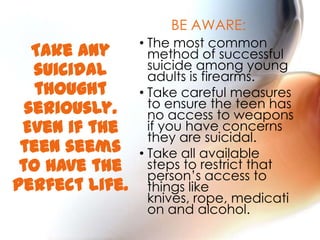Teen suicide
- 2. •Suicide is the third leading cause of death among all people between the ages of 10-24. • Approximately 4,600 lives lost each year • There is a gender difference • Males comprise 81% of all completed suicides • Females attempt suicide more often then males To See More Stats Click Here The Numbers Show:
- 3. Learning the warning signs of suicide prevention is a huge part of preventing a crisis!
- 4. • Not care about their future: “It won’t matter soon anyway.” • Put themselves down: “I don’t deserve to live.” • Express hopelessness: “Things will never get better.” • Say goodbye to important people: “You’re the best friend I have ever had. I’ll miss you.” • Have a specific plan: “I’ve thought about how I’d like to do it.” • Talk about feeling suicidal: “Life is so hard. Lately I’ve felt like ending it.” Have you heard someone…
- 5. • Using drugs or alcohol more than usual. • Pulling back from friends and family • Giving away their most valuable possessions • Neglecting their personal appearance • Losing interest in their favorite things to do • Eating or sleeping more or less than usual • Feeling more sick, tired or achy than usual • Admiring people who have died by suicide • Planning for death by writing a will or letter Have you noticed someone…
- 6. If you recognize these signs in someone you know, please take action.
- 7. • Remain calm. • Ask the youth directly if he or she is thinking about suicide. • Focus on their wellbeing and avoid being accusatory. • Listen. • Reassure them there is help and they will not feel this way forever. • Do not judge. • Provide constant supervision. Do not leave the youth alone. • Remove means for self-harm. • Seek help. • 1-877-695-NEED (6333) Local Crisis Suicide Prevention Hotline. Take Action…
- 8. • The most common method of successful suicide among young adults is firearms. • Take careful measures to ensure the teen has no access to weapons if you have concerns they are suicidal. • Take all available steps to restrict that person’s access to things like knives, rope, medicati on and alcohol. Take any suicidal thought seriously. Even if the teen seems to have the perfect life. BE AWARE:
- 9. At some point, we all face difficulties, such as family problems, loss, illness or crisis. Being resilient is an important part of dealing with adversity. Parents can help their children learn to face challenges successfully. • Think Positive: Modeling positive attitudes and emotions is very important. Children need to hear parents being determined to reach a goal. • Express love and gratitude: Praise should always occur more often than criticism. Children and adolescents who are cared for, loved and supported learn to express positive emotions to others and buffers against depression. • Express yourself: Parents who help kids become more aware of emotions, label emotions appropriately, and help children deal with upsetting events are giving them useful life skills. • Get Fit: Good physical health prepares the body and mind to be more resilient. Healthy eating habits, regular exercise and adequate sleep help protect kids against the stress of tough situations. • Foster competency: Children who achieve academic success and who develop individual talents, such as playing sports, drawing, dancing, or building things are much more likely to be able to deal with stress positively. Build Resiliency in Your Child…
- 10. Jane B. Conn, VFC Director Megan Crouch, VFC Prevention Education Coordinator Pat Clark, VFC Prevention Education Ohio Department of Health Ohio Domestic Violence Network Ohio Alliance to End Sexual Violence Find us at: www.arcshelter.org www.facebook.com/ViolenceFreeCoalition FOR MORE INFORMATION ON THE SUBJECT CLICK HERE! “This publication/material was supported by the 5VF1CE001114-3 from the Center for Disease Control and Prevention. Its contents are solely the responsibility of the authors and do not necessary represent the official views of the Center for Disease Control and Prevention”










